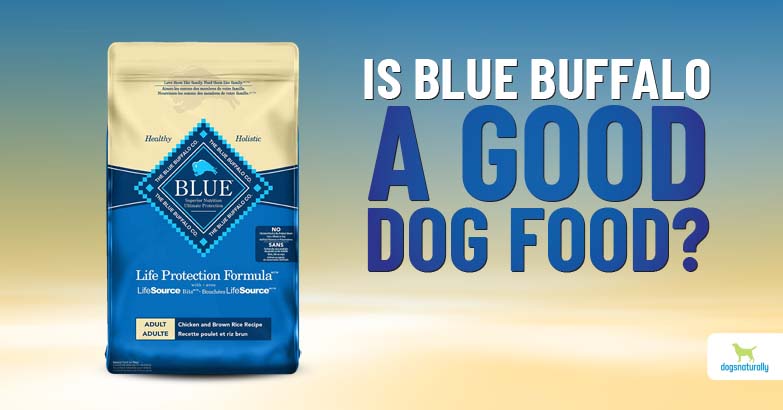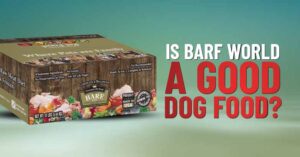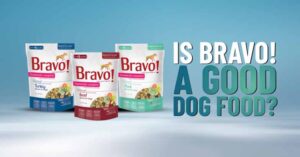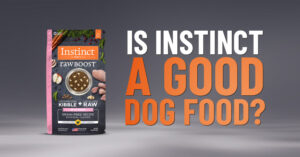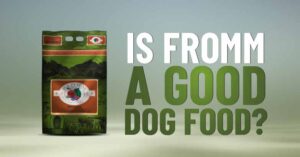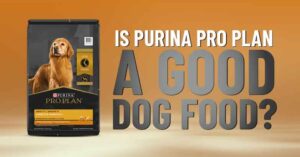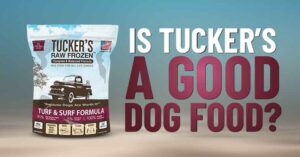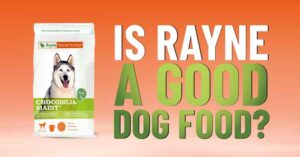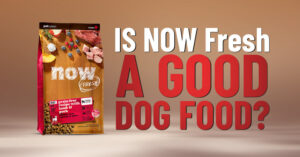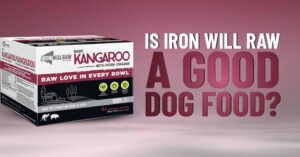Blue Buffalo began as a private company in 2003 operating out of the family barn in Connecticut, and is now owned by General Mills, a public company with more than 100 subsidiaries. Blue Buffalo produces 10 lines of dry and canned foods for dogs. All of their foods are made in the US where they have 2 manufacturing plants in Joplin, MO and Richmond, IN. They also work with third party manufacturers. The company has headquarters in Wilton, CT. To date, Blue Buffalo has raised over $30 million for pet cancer research in honor of company namesake, Blue.
For our Blue Buffalo dog food reviews we’ll look at each food line individually, based on the food ingredient quality and safety. There are 10 lines of 134 dog foods. Each dog food review was based on these criteria.
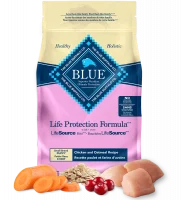
Blue Life Protection Formula Dog Food Review
Score: 2.2/10
Package Ingredients for Small Breed Chicken and Oatmeal Recipe: Deboned Chicken, chicken meal, oatmeal, barley, menhaden fish meal (source of omega 3 fatty acids), peas, dried egg product, brown rice, chicken fat (preserved with mixed tocopherols), dried tomato pomace, flaxseed (source of omega 6 fatty acids), natural flavour, pea protein, fish oil (source of ara-arachidonic acid and dha-docosahexaenoic acid), dicalcium phosphate, salt, dehydrated alfalfa meal, potassium chloride, potatoes, dried chicory root, choline chloride, pea fibre, alfalfa nutrient concentrate, calcium carbonate, dl-methionine, preserved with mixed tocopherols, vitamin E supplement, sweet potatoes, carrots, garlic, zinc amino acid chelate, zinc sulfate, vegetable juice for colour, ferrous sulfate, iron amino acid chelate, blueberries, cranberries, barley grass, parsley, turmeric, dried kelp, yucca schidigera extract, niacin (vitamin B3), calcium pantothenate (vitamin B5), l-ascorbyl-2-polyphosphate (source of vitamin C), L-Lysine, copper sulfate, biotin (vitamin B7), L-Carnitine, vitamin A supplement, copper amino acid chelate, manganese sulfate, taurine, manganese amino acid chelate, thiamine mononitrate (vitamin B1), riboflavin (vitamin B2), vitamin D3 supplement, vitamin B12 supplement, pyridoxine hydrochloride (vitamin B6), calcium iodate, dried yeast, dried enterococcus faecium fermentation product, dried lactobacillus acidophilus fermentation product, dried aspergillus niger fermentation extract, dried trichoderma longibrachiatum fermentation extract, dried bacillus subtilis fermentation extract, folic acid (vitamin B9), sodium selenite, oil of Rosemary
Using our evaluation criteria, Blue Life Protection is considered a very high risk dog food. Here are our concerns:
Ingredient Quality
Overall, there are several concerns when it comes to ingredient quality:
High Carbohydrates: Carbohydrates as calculated in this line average 40.5%, which is very high. Blue Buffalo states it doesn’t use wheat, corn or soy in these recipes, however they include oatmeal, barley, rice and peas and sweet potatoes which are high in starch. High carbohydrate diets have been linked to gut imbalance. High carbohydrate diets also lead to a lower protein diet and this holds true here with 23.6% protein, which is much lower than the carbohydrates.
Excessive Added Vitamins and Minerals: When foods are highly processed and/or contain lower quality ingredients, a vitamin and mineral premix must be added for the food to meet minimum AAFCO nutritional requirements. These premixes can often cause toxicities, especially for vitamin D and copper.
Added Amino Acids: Protein from animals is more complete in amino acids than protein from plants – plus it’s more expensive. Foods with lower amounts of animal protein often need to add amino acids to compensate, so 2 or more added amino acids can be a marker of cheap, lower quality ingredients.
Unnamed Animal Ingredients: Unnamed animal ingredients are a sign of low quality. These foods contain fish oil that can be made from any type of fish. Unnamed animal ingredients are often a less expensive, low quality ingredient that can be made from rendered waste of many proteins.
Contains Plant Protein: Plant-based protein sources are the least expensive substitute for quality animal protein. Whenever possible, animal sources of protein are preferred because they contain a wider array of amino acids than plant based protein sources. Animal protein is more digestible.
Cellulose: Cellulose is a low quality fiber. Dogs have no known need for fiber, but soluble fiber is fermented by gut bacteria, which supports gut health. Cellulose is an insoluble fiber made from wood pulp. It’s the least expensive and least functional form of fiber since it’s very poorly fermented. It is included as filler and to firm stools.
Ingredient Safety
Many pet food ingredients are unsafe or are grown using unsafe chemicals. Here are some of concerns with Blue Life Protection Formula:
Ultra-Processed: Most kibbles undergo four heating steps, making them an ultra-processed food. Ultra-processed foods are deficient in food-based nutrients and enzymes, and can also be high in toxic chemicals like acrylamides, heterocyclic amines and PBDEs. In fact, research shows that ultra-processed foods are linked to an increase in all-cause mortality in humans.
High Pesticide/Herbicide Foods In The Top 5 Ingredients: The recipes in this line all contain foods in the top 5 ingredients that are known to carry a large pesticide/herbicide residue. Oatmeal, barley and peas (unless organic) are crops that are spray-dried with Roundup, leaving them with more glyphosate/herbicide residue than other crops, even genetically modified ones. Glyphosate is an antibiotic that can kill beneficial gut bacteria and has been linked to cancer and other diseases.
Contains GMO Foods: Several recipes in this line contain known GMO ingredients including potatoes and alfalfa. There are limited safety studies on genetically modified and Roundup Ready crops although they are lacking in nutrients compared to non-GMO foods. GMO crops also strip nutrients from soils, require increased pesticide risk and may be involved in bee die-off.
Rice: Arsenic contamination is a significant concern with rice since it naturally absorbs arsenic and the water it’s grown in can be contaminated with arsenic. Arsenic is linked to chronic health issues.
Natural Flavor: Foods in this line contain natural flavor, which is added to make processed food more palatable. Natural flavor is often either MSG or animal digest, both low quality ingredients with limited safety studies.
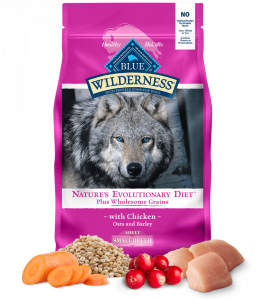
Blue Wilderness Dog Food Review
Score: 3.4/10
Package Ingredients for Chicken Recipe: Deboned chicken, chicken meal (source of glucosamine), peas, pea protein, tapioca starch, menhaden fish meal (source of omega 3 fatty acids), dried tomato pomace, chicken fat (preserved with mixed tocopherols), flaxseed (source of omega 6 fatty acids), pea starch, natural flavour, dried egg product, dehydrated alfalfa meal, DL-Methionine, potatoes, dried chicory root, pea fibre, alfalfa nutrient concentrate, calcium carbonate, choline chloride, salt, potassium chloride, sweet potatoes, carrots, preserved with mixed tocopherols, zinc amino acid chelate, zinc sulfate, vegetable juice for colour, ferrous sulfate, vitamin E supplement, iron amino acid chelate, blueberries, cranberries, barley grass, parsley, turmeric, dried kelp, yucca schidigera extract, niacin (vitamin B3), calcium pantothenate (vitamin B5), L-Carnitine, copper sulfate, L-ascorbyl-2-polyphosphate (source of vitamin C), L-Lysine, biotin (vitamin B7), vitamin A supplement, copper amino acid chelate, manganese sulfate, taurine, manganese amino acid chelate, thiamine mononitrate (vitamin B1), riboflavin (vitamin B2), vitamin D3 supplement, vitamin B12 supplement, pyridoxine hydrochloride (vitamin B6), calcium iodate, dried yeast, dried enterococcus faecium fermentation product, dried Lactobacillus acidophilus fermentation product, dried Aspergillus niger fermentation extract, dried Trichoderma longibrachiatum fermentation extract, dried Bacillus subtilis fermentation extract, folic acid (vitamin B9), sodium selenite, oil of Rosemary
Using our evaluation criteria, Blue Wilderness is considered a high risk dog food. Here are our concerns:
Ingredient Quality
Overall, there are several concerns when it comes to ingredient quality:
Moderately High Carbohydrates: Carbohydrates as calculated in this line average 29.2%. This is higher than we’d like to see but it should be noted this is the lowest amount of all Blue Buffalo dry foods. Blue Buffalo states that they don’t include corn, wheat or soy, but these recipes include oats, barley, tapioca, peas, sweet potatoes and potatoes, which are all starchy ingredients. High carbohydrate diets have been linked to gut imbalance. High carbohydrate diets result in low protein diets, but average protein content for this line is 33%, which is the highest of all Blue Buffalo dry foods.
Excessive Added Vitamins and Minerals: When foods are highly processed and/or contain lower quality ingredients, a vitamin and mineral premix must be added for the food to meet minimum AAFCO nutritional requirements. These premixes can often cause toxicities, especially for vitamin D and copper.
Added Amino Acids: Protein from animals is more complete in amino acids than protein from plants – plus it’s more expensive. Foods with lower amounts of animal protein often need to add amino acids to compensate, so 2 or more added amino acids can be a marker of cheap, lower quality ingredients.
Unnamed Animal Ingredients: Unnamed animal ingredients are a sign of low quality. These foods contain fish oil that can be made from any type of fish. Unnamed animal ingredients are often a less expensive, low quality ingredient that can be made from rendered waste of many proteins.
Contains Plant Protein: Plant-based protein sources are the least expensive substitute for quality animal protein. Whenever possible, animal sources of protein are preferred because they contain a wider array of amino acids than plant based protein sources. Animal protein is more digestible.
Cellulose: Cellulose is a low quality fiber. Dogs have no known need for fiber, but soluble fiber is fermented by gut bacteria, which supports gut health. Cellulose is an insoluble fiber made from wood pulp. It’s the least expensive and least functional form of fiber since it’s very poorly fermented. It is included to firm stools.
Ingredient Safety
Many pet food ingredients are unsafe or are grown using unsafe chemicals. Here are some of the issues with Blue Wilderness:
Ultra-Processed: Most kibbles undergo four heating steps, making them an ultra-processed food. Ultra-processed foods are deficient in food-based nutrients and enzymes, and can also be high in toxic chemicals like acrylamides, heterocyclic amines and PBDEs. In fact, research shows that ultra-processed foods are linked to an increase in all-cause mortality in humans.
High Pesticide/Herbicide Foods In The Top 5 Ingredients: The recipes in this line contain foods in the top 5 ingredients that are known to carry a large pesticide/herbicide residue. Oats, peas and barley (unless organic) are crops that are spray-dried with Roundup, leaving them with more glyphosate/herbicide residue than other crops, even genetically modified ones. Glyphosate is an antibiotic that can kill beneficial gut bacteria and has been linked to cancer and other diseases.
GMO Foods: Potatoes are a known GMO ingredient that appear in several recipes. There are limited safety studies on genetically modified and Roundup Ready crops although they are lacking in nutrients compared to non-GMO foods. GMO crops also strip nutrients from soils, require increased pesticide risk and may be involved in bee die-off.
Natural Flavor: Foods in this line contain natural flavor, which is added to make processed food more palatable. Natural flavor is often either MSG or animal digest, both low quality ingredients with limited safety studies.
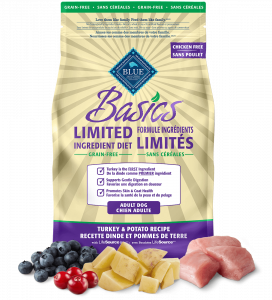
Blue Basics Dry Dog Food Review
Score: 1.3/10
Package Ingredients for Grain-Free Turkey and Potato Recipe: Deboned turkey, potatoes, turkey meal (source of glucosamine), pea starch, peas, tapioca starch, pea fibre, potato starch, canola oil (source of omega 6 fatty acids), natural flavour, pea protein, fish oil (source of omega 3 fatty acids), potassium chloride, salt, dehydrated alfalfa meal, calcium carbonate, dicalcium phosphate, choline chloride, pumpkin, dried chicory root, flaxseed, alfalfa nutrient concentrate, vitamin e supplement, preserved with mixed tocopherols, L-ascorbyl-2-polyphosphate (source of vitamin C), DL-methionine, zinc amino acid chelate, zinc sulfate, vegetable juice for colour, ferrous sulfate, iron amino acid chelate, blueberries, cranberries, barley grass, parsley, turmeric, dried kelp, yucca schidigera extract, niacin (vitamin B3), calcium pantothenate (vitamin B5), copper sulfate, L-Lysine, biotin (vitamin B7), vitamin A supplement, copper amino acid chelate, dried yeast, manganese sulfate, dried Enterococcus faecium fermentation product, dried Lactobacillus acidophilus fermentation product, taurine, manganese amino acid chelate, dried Aspergillus niger fermentation extract, dried Trichoderma longibrachiatum fermentation extract, dried Bacillus subtilis fermentation extract, thiamine mononitrate (vitamin B1), riboflavin (vitamin B2), vitamin D3 supplement, vitamin B12 supplement, pyridoxine hydrochloride (vitamin B6), calcium iodate, folic acid (vitamin B9), sodium selenite, oil of Rosemary
Using our evaluation criteria, Blue Basics is considered a very hig risk dog food. Here are our concerns:
Ingredient Quality
Overall, there are several concerns when it comes to ingredient quality:
High Carbohydrates: Carbohydrates as calculated in this line average 43.4%, which is very high, and it’s the highest in all Blue Buffalo lines. The company states it doesn’t use wheat, corn or soy in these recipes, however they include oats, tapioca, peas, pumpkin, potatoes and rice which are high in starch. High carbohydrate diets have been linked to gut imbalance. High carbohydrate diets also lead to a lower protein diet which holds true here with 20.8% protein with two times more carbohydrates than protein.
Excessive Added Vitamins and Minerals: When foods are highly processed and/or contain lower quality ingredients, a vitamin and mineral premix must be added for the food to meet minimum AAFCO nutritional requirements. These premixes can often cause toxicities, especially for vitamin D and copper.
Added Amino Acids: Protein from animals is more complete in amino acids than protein from plants – plus it’s more expensive. Foods with lower amounts of animal protein often need to add amino acids to compensate, so 2 or more added amino acids can be a marker of cheap, lower quality ingredients.
Unnamed Animal Ingredients: Unnamed animal ingredients are a sign of low quality. These foods contain fish oil that can be made from any type of fish. Unnamed animal ingredients are often a less expensive, low quality ingredient that can be made from rendered waste of many proteins.
Contains Seed Oil: Some of these recipes contain canola oil, which is a highly processed and highly inflammatory oil. It’s an inexpensive alternative to higher quality animal fats and oils.
Contains Plant Protein: Plant-based protein sources are the least expensive substitute for quality animal protein. Whenever possible, animal sources of protein are preferred because they contain a wider array of amino acids than plant based protein sources. Animal protein is more digestible.
Cellulose: Cellulose is low quality, insoluble fiber made from wood pulp. It’s the least expensive and least functional form of fiber since it’s very poorly fermented. In this case, it’s included to firm stools. Dogs have no known need for fiber, unless it’s soluble fiber that’s fermented by gut bacteria, to support gut health.
Ingredient Safety
Many pet food ingredients are unsafe or are grown using unsafe chemicals. Here are some concerns with Blue Basics:
Ultra-Processed: Most kibbles undergo four heating steps, making them an ultra-processed food. Ultra-processed foods are deficient in food-based nutrients and enzymes, and can also be high in toxic chemicals like acrylamides, heterocyclic amines and PBDEs. In fact, research shows that ultra-processed foods are linked to an increase in all-cause mortality in humans.
High Pesticide/Herbicide Foods In The Top 5 Ingredients: The recipes in Blue Basics all contain foods in the top 5 ingredients that are known to carry a large pesticide/herbicide residue. Peas and oatmeal (unless organic) are crops that are spray-dried with Roundup, leaving them with more glyphosate/herbicide residue than other crops, even genetically modified ones. Glyphosate is an antibiotic that can kill beneficial gut bacteria and has been linked to cancer and other diseases.
Contains GMO Foods in The Top 5 Ingredients: These recipes contain known GMO ingredients like potatoes in the top 5 ingredients. There are limited safety studies on genetically modified and Roundup Ready crops although they are lacking in nutrients compared to non-GMO foods. GMO crops also strip nutrients from soils, require increased pesticide risk and may be involved in bee die-off.
Rice: Arsenic contamination is a significant concern with rice since it naturally absorbs arsenic and the water it’s grown in can be contaminated with arsenic. Arsenic is linked to chronic health issues.
Natural Flavor: Foods in this line contain natural flavor, which is added to make processed food more palatable. Natural flavor is often either MSG or animal digest, both low quality ingredients with limited safety studies.
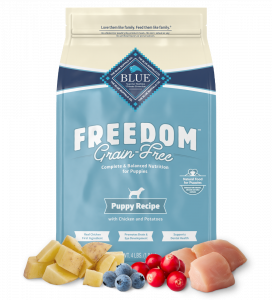
Blue Freedom Dry Dog Food Review
Score: 2.3/10
Package Ingredients for Grain-Free Puppy Chicken Recipe: Deboned chicken, chicken meal, peas, potatoes, pea starch, turkey meal, pea protein, chicken fat (preserved with mixed tocopherols), tapioca starch, dried tomato pomace, flaxseed (source of omega 3 & 6 fatty acids), natural flavour, dried egg product, fish oil (source of ara-arachidonic acid and dha-docosahexaenoic acid), dicalcium phosphate, salt, dehydrated alfalfa meal, choline chloride, dried chicory root, pea fibre, alfalfa nutrient concentrate, calcium carbonate, dl-methionine, potassium chloride, preserved with mixed tocopherols, sweet potatoes, carrots, garlic, zinc amino acid chelate, zinc sulfate, vegetable juice for colour, ferrous sulfate, vitamin e supplement, iron amino acid chelate, blueberries, cranberries, barley grass, parsley, turmeric, dried kelp, yucca schidigera extract, niacin (vitamin B3), calcium pantothenate (vitamin B5), L-ascorbyl-2-polyphosphate (source of vitamin C), L-Lysine, copper sulfate, L-Carnitine, biotin (vitamin B7), vitamin a supplement, copper amino acid chelate, manganese sulfate, taurine, manganese amino acid chelate, thiamine mononitrate (vitamin B1), riboflavin (vitamin B2), vitamin D3 supplement, vitamin B12 supplement, pyridoxine hydrochloride (vitamin B6), calcium iodate, dried yeast, dried Enterococcus faecium fermentation product, dried Lactobacillus Acidophilus fermentation product, dried Aspergillus niger fermentation extract, dried Trichoderma longibrachiatum fermentation extract, dried Bacillus subtilis fermentation extract, folic acid (vitamin B9), sodium selenite, oil of Rosemary
Using our evaluation criteria, Blue Freedom is considered a very high risk dog food. Here are our concerns:
Ingredient Quality
Overall, there are several concerns when it comes to ingredient quality:
High Carbohydrates: Carbohydrates as calculated in this line average 39.6%, which is very high for any dog food. Blue Buffalo states it doesn’t use wheat, corn or soy in these recipes, however they include potatoes, tapioca, peas and sweet potatoes which are high in starch. High carbohydrate diets have been linked to gut imbalance. High carbohydrate diets also lead to a lower protein diet which holds true here with 23.7% protein, which is much lower than the carbohydrates.
Excessive Added Vitamins and Minerals: When foods are highly processed and/or contain lower quality ingredients, a vitamin and mineral premix must be added for the food to meet minimum AAFCO nutritional requirements. These premixes can often cause toxicities, especially for vitamin D and copper.
Added Amino Acids: Protein from animals is more complete in amino acids than protein from plants – plus it’s more expensive. Foods with lower amounts of animal protein often need to add amino acids to compensate, so 2 or more added amino acids can be a marker of cheap, lower quality ingredients.
Unnamed Animal Ingredients: Unnamed animal ingredients are a sign of low quality. These foods contain fish oil that can be made from any type of fish. Unnamed animal ingredients are often a less expensive, low quality ingredient that can be made from rendered waste of many proteins.
Contains Plant Protein: Plant-based protein sources are the least expensive substitute for quality animal protein. Whenever possible, animal sources of protein are preferred because they contain a wider array of amino acids than plant based protein sources. Animal protein is more digestible.
Ingredient Safety
Many pet food ingredients are unsafe or are grown using unsafe chemicals. Here are some of the issues with Blue Freedom line:
Ultra-Processed: Most kibbles undergo four heating steps, making them an ultra-processed food. Ultra-processed foods are deficient in food-based nutrients and enzymes, and can also be high in toxic chemicals like acrylamides, heterocyclic amines and PBDEs. In fact, research shows that ultra-processed foods are linked to an increase in all-cause mortality in humans.
High Pesticide/Herbicide Foods In The Top 5 Ingredients: The recipes in Blue Freedom contain foods in the top 5 ingredients that are known to carry a large pesticide/herbicide residue. Peas (unless organic) are crops that are spray-dried with Roundup, leaving them with more glyphosate/herbicide residue than other crops, even genetically modified ones. Glyphosate is an antibiotic that can kill beneficial gut bacteria and has been linked to cancer and other diseases.
GMO Foods in The Top 5 Ingredients: These recipes contain known GMO ingredients in the top 5 ingredients including potatoes. There are limited safety studies on genetically modified and Roundup Ready crops although they are lacking in nutrients compared to non-GMO foods. GMO crops also strip nutrients from soils, require increased pesticide risk and may be involved in bee die-off.
Natural Flavor: Foods in this line contain natural flavor, which is added to make processed food more palatable. Natural flavor is often either MSG or animal digest, both low quality ingredients with limited safety studies.
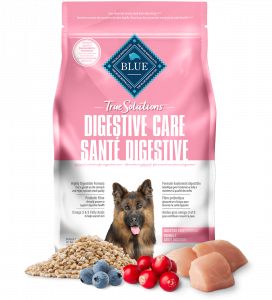
Blue True Solutions Dry Dog Food Review
Score: 1.1/10
Package Ingredients for Digestve Care Formula: Deboned chicken, chicken meal, brown rice, oatmeal, barley, potatoes, dried egg product, natural flavour, flaxseed (source of omega 3 fatty acids), dried tomato pomace, dried plain beet pulp, canola oil (source of omega 6 fatty acids), peas, pea protein, salt, calcium carbonate, hydrolyzed yeast, fructooligosaccharides, pea fibre, alfalfa nutrient concentrate, dehydrated alfalfa meal, potassium chloride, choline chloride, taurine, L-Threonine, vitamin E supplement, preserved with mixed tocopherols, L-ascorbyl-2-polyphosphate (source of vitamin C), L-Tryptophan, DL-Methionine, zinc amino acid chelate, zinc sulfate, vegetable juice for colour, ferrous sulfate, iron amino acid chelate, blueberries, cranberries, barley grass, parsley, turmeric, dried kelp, yucca schidigera extract, niacin (vitamin B3), calcium pantothenate (vitamin B5), copper sulfate, biotin (vitamin B7), L-Lysine, vitamin A supplement, copper amino acid chelate, manganese sulfate, manganese amino acid chelate, dried yeast, dried Enterococcus faecium fermentation product, dried Lactobacillus acidophilus fermentation product, dried Aspergillus niger fermentation extract, dried Trichoderma longibrachiatum fermentation extract, dried Bacillus subtilis fermentation extract, thiamine mononitrate (vitamin B1), riboflavin (vitamin B2), vitamin D3 supplement, vitamin B12 supplement, pyridoxine hydrochloride (vitamin B6), calcium iodate, folic acid (vitamin B9), sodium selenite, oil of Rosemary
Using our evaluation criteria, Blue True Solutions is considered a very high risk dog food. Here are our concerns:
Ingredient Quality
Overall, there are several concerns when it comes to ingredient quality:
High Carbohydrates: Carbohydrates as calculated in this line average 36.3%, which is very high. Blue Buffalo states it doesn’t use wheat, corn or soy in these recipes, however they include oatmeal, barley, rice and peas and sweet potatoes which are high in starch. High carbohydrate diets have been linked to gut imbalance. High carbohydrate diets also lead to a lower protein diet which holds true here with 25% protein, which is much lower than the carbohydrates.
Excessive Added Vitamins and Minerals: When foods are highly processed and/or contain lower quality ingredients, a vitamin and mineral premix must be added for the food to meet minimum AAFCO nutritional requirements. These premixes can often cause toxicities, especially for vitamin D and copper.
Added Amino Acids: Protein from animals is more complete in amino acids than protein from plants – plus it’s more expensive. Foods with lower amounts of animal protein often need to add amino acids to compensate, so 2 or more added amino acids can be a marker of cheap, lower quality ingredients.
Unnamed Animal Ingredients: Unnamed animal ingredients are a sign of low quality. These foods contain fish oil that can be made from any type of fish. Unnamed animal ingredients are often a less expensive, low quality ingredient that can be made from rendered waste of many proteins.
Contains Seed Oil: Some of these recipes contain canola oil, which is a highly processed and highly inflammatory oil. It’s an inexpensive alternative to higher quality animal fats and oils.
Contains Plant Protein: Plant-based protein sources are the least expensive substitute for quality animal protein. Whenever possible, animal sources of protein are preferred because they contain a wider array of amino acids than plant based protein sources. Animal protein is more digestible.
Ingredient Safety
Many pet food ingredients are unsafe or are grown using unsafe chemicals. Here are some concerns with Blue True Solutions:
Ultra-Processed: Most kibbles undergo four heating steps, making them an ultra-processed food. Ultra-processed foods are deficient in food-based nutrients and enzymes, and can also be high in toxic chemicals like acrylamides, heterocyclic amines and PBDEs. In fact, research shows that ultra-processed foods are linked to an increase in all-cause mortality in humans.
High Pesticide/Herbicide Foods In The Top 5 Ingredients: These recipes contain foods in the top 5 ingredients that are known to carry a large pesticide/herbicide residue. Oatmeal and barley (unless organic) are crops that are spray-dried with Roundup, leaving them with more glyphosate/herbicide residue than other crops, even genetically modified ones. Glyphosate is an antibiotic that can kill beneficial gut bacteria and has been linked to cancer and other diseases.
GMO Foods (in The Top 5 Ingredients): This line of foods contain known GMO ingredients that include potatoes. There are limited safety studies on genetically modified and Roundup Ready crops although they are lacking in nutrients compared to non-GMO foods. GMO crops also strip nutrients from soils, require increased pesticide risk and may be involved in bee die-off.
Rice: Arsenic contamination is a significant concern with rice since it naturally absorbs arsenic and the water it’s grown in can be contaminated with arsenic. Arsenic is linked to chronic health issues.
Natural Flavor: Foods in this line contain natural flavor, which is added to make processed food more palatable. Natural flavor is often either MSG or animal digest, both low quality ingredients with limited safety studies.
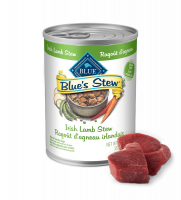
Blue Life Protection Wet Dog Food Review
Score: 5.6/10
Package Ingredients for Irish Lamb Stew Recipe: Lamb, lamb broth, water, lamb liver, chicken, dried egg product, peas, carrots, potatoes, potato starch, guar gum, sodium phosphate, calcium carbonate, potassium chloride, natural flavour, salt, zinc amino acid chelate, iron amino acid chelate, choline chloride, vitamin E supplement, copper amino acid chelate, manganese amino acid chelate, sodium selenite, thiamine mononitrate (vitamin B1), cobalt amino acid chelate, niacin supplement (vitamin B3), calcium pantothenate (vitamin B5), vitamin a supplement, riboflavin supplement (vitamin B2), biotin (vitamin B7), vitamin B12 supplement, potassium iodide, pyridoxine hydrochloride (vitamin B6), vitamin D3 supplement, folic acid (vitamin B9)
Using our evaluation criteria, Blue Life Protection Wet is considered a moderate risk dog food. Here are our concerns:
Ingredient Quality
Overall, there are several concerns when it comes to ingredient quality:
Moderately High In Carbohydrate: The carbohydrates as calculated in this line vary from 11% to 32% (on a dry matter basis) with an average of 20%. Lower is preferred but this is acceptable for a canned food. Blue Buffalo doesn’t use wheat, corn or soy in its recipes but it does include peas, oatmeal, barley, potatoes and rice, which are high in starch. High carbohydrate diets have been linked to gut imbalance. High carbohydrate diets also lead to a lower protein diet however this is an exception with 43% average protein (dry matter basis), an acceptable amount for a canned food.
Excessive Added Vitamins and Minerals: When foods are highly processed and/or contain lower quality ingredients, a vitamin and mineral premix must be added for the food to meet minimum AAFCO nutritional requirements. These premixes can often cause toxicities, especially for vitamin D and copper.
Unnamed Animal Ingredients: Unnamed animal ingredients are a sign of low quality. These foods contain fish oil that can be made from any type of fish. Unnamed animal ingredients are often a less expensive, low quality ingredient that can be made from rendered waste of many proteins.
Sugar: Sugar is often found in pet food to increase the palatability or as a preservative or humectant. Molasses is an added sugar in this food. It is a low quality ingredient that can cause unwanted gut changes, obesity and insulin spikes.
Ingredient Safety
Many pet food ingredients are unsafe or are grown using unsafe chemicals. Here are some concerns with Blue Life Protection Wet:
Highly Processed: Canned foods are heated before and during canning, which will cause significant losses in some active enzymes, vitamins, amino acids and phytonutrients.
High Pesticide/Herbicide Foods In The Top 5 Ingredients: These recipes have foods in the top 5 ingredients that are known to carry a large pesticide/herbicide residue including peas. Legume crops are spray-dried with Roundup leaving them with more glyphosate/herbicide residue than other crops. Glyphosate is an antibiotic that can kill beneficial gut bacteria and has been linked to cancer and other diseases.
GMO Foods (in The Top 5 Ingredients): Potatoes are a known GMO food found in the top 5 ingredients. There are limited safety studies on genetically modified and Roundup Ready crops although they are lacking in nutrients compared to non-GMO foods. GMO crops also strip nutrients from soils, require increased pesticide risk and may be involved in bee die-off.
Carrageenan: Carrageenan is a highly processed derivative of seaweed used as a thickener or texturizer that may be linked to intestinal inflammation and other negative health effects.
Rice: Arsenic contamination is a significant concern with rice since it naturally absorbs arsenic and the water it’s grown in can be contaminated with arsenic. Arsenic is linked to chronic health issues.
Natural Flavor: Foods in this line contain natural flavor, which is added to make processed food more palatable. Natural flavor is often either MSG or animal digest, both low quality ingredients with limited safety studies.
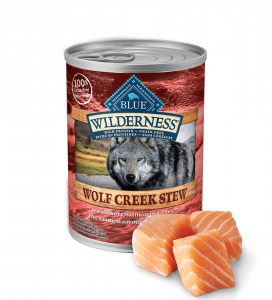
Blue Wilderness Wet Dog Food Review
Score: 6.1/10
Package Ingredients for Savoury Salmon Stew Recipe: Chicken, chicken broth, water, chicken liver, dried egg product, salmon, peas, potatoes, chicken meal, potato starch, guar gum, pea fibre, salt, sodium phosphate, potassium chloride, choline chloride, zinc amino acid chelate, iron amino acid chelate, xanthan gum, thiamine mononitrate (vitamin B1), vitamin E supplement, copper amino acid chelate, manganese amino acid chelate, sodium selenite, cobalt amino acid chelate, niacin supplement (vitamin B3), calcium pantothenate (vitamin B5), vitamin A supplement, riboflavin supplement (vitamin B2), biotin (vitamin B7), vitamin B12 supplement, potassium iodide, pyridoxine hydrochloride (vitamin B6), vitamin D3 supplement, folic acid (vitamin B9)
Using our evaluation criteria, Blue Wilderness Wet is considered a moderate risk dog food. Here are our concerns:
Ingredient Quality
Overall, there are several concerns when it comes to ingredient quality:
Low Carbohydrates: This food averages 14% carbohydrate (as calculated on a dry matter basis) which is acceptable. It’s a bit higher than other canned foods, and it’s the best score among all Blue Buffalo wet foods. Foods that are high in carbohydrates can increase insulin levels, increase the risk of obesity and cause unwanted changes to the gut microbiome.
Excessive Added Vitamins and Minerals: When foods are highly processed and/or contain lower quality ingredients, a vitamin and mineral premix must be added for the food to meet minimum AAFCO nutritional requirements. These premixes can often cause toxicities, especially for vitamin D and copper.
Unnamed Animal Ingredients: Unnamed animal ingredients are a sign of low quality. These foods contain fish oil that can be made from any type of fish. Unnamed animal ingredients are often a less expensive, low quality ingredient that can be made from rendered waste of many proteins.
Contains Seed Oil: Some of these recipes contain sunflower oil, which is a highly processed and highly inflammatory oil. It’s an inexpensive alternative to higher quality animal fats and oils.
Contains Plant Protein: Plant-based protein sources are the least expensive substitute for quality animal protein. Whenever possible, animal sources of protein are preferred because they contain a wider array of amino acids than plant based protein sources. Animal protein is more digestible.
Ingredient Safety
Many pet food ingredients are unsafe or are grown using unsafe chemicals. Here are some concerns with Blue Wilderness Wet:
Highly Processed: Canned foods are heated before and during canning, which will cause significant losses in some active enzymes, vitamins, amino acids and phytonutrients.
High Pesticide/Herbicide Foods In The Top 5 Ingredients: These recipes contain peas in the top 5 ingredients that are known to carry a large pesticide/herbicide residue. Crops that are spray-dried with Roundup, leaves them with more glyphosate/herbicide residue than other crops, even genetically modified ones. Glyphosate is an antibiotic that can kill beneficial gut bacteria and has been linked to cancer and other diseases.
GMO Foods (in The Top 5 Ingredients): These recipes contain known GMO ingredients in the top 5 ingredients that include potatoes. There are limited safety studies on genetically modified and Roundup Ready crops although they are lacking in nutrients compared to non-GMO foods. GMO crops also strip nutrients from soils, require increased pesticide risk and may be involved in bee die-off.
Carrageenan: Carrageenan is a highly processed derivative of seaweed used as a thickener or texturizer that may be linked to intestinal inflammation and other negative health effects.
Natural Flavor: Foods in this line contain natural flavor, which is added to make processed food more palatable. Natural flavor is often either MSG or animal digest, both low quality ingredients with limited safety studies.
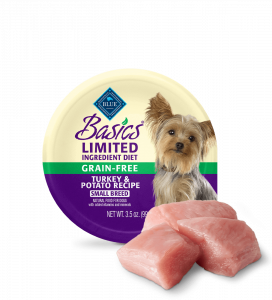
Blue Basics Wet Dog Food Review
Score: 3.9/10
Package Ingredients for Grain-Free Turkey And Potato Recipe: Turkey, turkey broth, potatoes, flaxseed (source of omega 3 and 6 fatty acids), pea protein, fish oil, pumpkin, guar gum, potassium chloride, salt, carrageenan, cassia gum, cranberries, blueberries, choline chloride, zinc amino acid chelate, iron amino acid chelate, vitamin E supplement, L-ascorbyl-2-polyphosphate (source of vitamin C), copper amino acid chelate, manganese amino acid chelate, sodium selenite, thiamine mononitrate (vitamin B1), cobalt amino acid chelate, niacin supplement (vitamin B3), calcium pantothenate (vitamin B5), vitamin a supplement, riboflavin supplement (vitamin B2), biotin (vitamin B7), vitamin B12 supplement, potassium iodide, pyridoxine hydrochloride (vitamin B6), vitamin D3 supplement, folic acid (vitamin B9), preserved with mixed tocopherols
Using our evaluation criteria, Blue Basics Wet is considered a high risk dog food. Here are our concerns:
Ingredient Quality
Overall, there are several concerns when it comes to ingredient quality:
Moderately High In Carbohydrate: Carbohydrates as calculated in this line average 24% (on a dry matter basis) which is high for a canned food. The carbohydrates come from peas, oatmeal, barley and potatoes which are high in starch. High carbohydrate diets have been linked to gut imbalance. High carbohydrate diets also lead to a lower protein diet which holds true here with 32% protein on a dry matter basis, which is low for a food in this category.
Excessive Added Vitamins and Minerals: When foods are highly processed and/or contain lower quality ingredients, a vitamin and mineral premix must be added for the food to meet minimum AAFCO nutritional requirements. These premixes can often cause toxicities, especially for vitamin D and copper.
Unnamed Animal Ingredients: Unnamed animal ingredients are a sign of low quality. These foods contain fish oil that can be made from any type of fish. Unnamed animal ingredients are often a less expensive, low quality ingredient that can be made from rendered waste of many proteins.
Contains Seed Oil: Some of these recipes contain sunflower oil, which is a highly processed and highly inflammatory oil. It’s an inexpensive alternative to higher quality animal fats and oils.
Contains Plant Protein: Plant-based protein sources are the least expensive substitute for quality animal protein. Whenever possible, animal sources of protein are preferred because they contain a wider array of amino acids than plant based protein sources. Animal protein is more digestible.
Ingredient Safety
Many pet food ingredients are unsafe or are grown using unsafe chemicals. Here are some concerns with Blue Basics Wet:
Highly Processed: Canned foods are heated before and during canning, which will cause significant losses in some active enzymes, vitamins, amino acids and phytonutrients.
High Pesticide/Herbicide Foods In The Top 5 Ingredients: The recipes in this line contain foods in the top 5 ingredients that are known to carry a large pesticide/herbicide residue. Peas (unless organic) are crops that are spray-dried with Roundup, leaving them with more glyphosate/herbicide residue than other crops, even genetically modified ones. Glyphosate is an antibiotic that can kill beneficial gut bacteria and has been linked to cancer and other diseases.
GMO Foods in The Top 5 Ingredients: Several recipes contain known GMO ingredients in the top 5 ingredients that include potatoes. There are limited safety studies on genetically modified and Roundup Ready crops although they are lacking in nutrients compared to non-GMO foods. GMO crops also strip nutrients from soils, require increased pesticide risk and may be involved in bee die-off.
Carrageenan: Carrageenan is a highly processed derivative of seaweed used as a thickener or texturizer that may be linked to intestinal inflammation and other negative health effects.
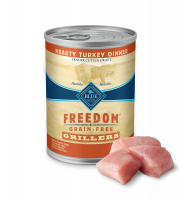
Blue Freedom Wet Dog Food Review
Score: 6.8/10
Package Ingredients for Grain-Free Grillers Hearty Turkey Dinner Recipe: Turkey, chicken broth, water, chicken, chicken liver, dried egg, peas, carrots, potato starch, guar gum, sodium phosphate, natural flavour, salt, potassium chloride, choline chloride, zinc amino acid chelate, iron amino acid chelate, xanthan gum, vitamin E supplement, copper amino acid chelate, manganese amino acid chelate, sodium selenite, thiamine mononitrate (vitamin B1), cobalt amino acid chelate, niacin supplement (vitamin B3), calcium pantothenate (vitamin B5), vitamin A supplement, riboflavin supplement (vitamin B2), biotin (vitamin B7), vitamin B12 supplement, potassium iodide, pyridoxine hydrochloride (vitamin B6), vitamin D3 supplement, folic acid (vitamin B9)
Using our evaluation criteria, Blue Freedom Wet is considered a moderate risk dog food. Here are our concerns:
Ingredient Quality
Overall, there are several concerns when it comes to ingredient quality:
Moderately High In Carbohydrate: The carbohydrates as calculated in this line vary from 11% to 29% (on a dry matter basis) for an average of 22%. This is an average range for a canned food. The carbohydrates primarily come from pea and potato products and sweet potatoes which are high in starch. High carbohydrate diets have been linked to gut imbalance. High carbohydrate diets also lead to a lower protein diet which holds true here with 38% protein (dry matter), which is lower than we’d expect to see in a canned food.
Excessive Added Vitamins and Minerals: When foods are highly processed and/or contain lower quality ingredients, a vitamin and mineral premix must be added for the food to meet minimum AAFCO nutritional requirements. These premixes can often cause toxicities, especially for vitamin D and copper.
Unnamed Animal Ingredients: Unnamed animal ingredients are a sign of low quality. These foods contain fish oil that can be made from any type of fish. Unnamed animal ingredients are often a less expensive, low quality ingredient that can be made from rendered waste of many proteins.
Ingredient Safety
Many pet food ingredients are unsafe or are grown using unsafe chemicals. Here are some concerns with Blue Freedom Wet:
Highly Processed: Canned foods are heated before and during canning, which will cause significant losses in some active enzymes, vitamins, amino acids and phytonutrients.
High Pesticide/Herbicide Foods In The Top 5 Ingredients: Some of these recipes contain foods in the top 5 ingredients that are known to carry a large pesticide/herbicide residue. Peas (unless organic) are crops that are spray-dried with Roundup, leaving them with more glyphosate/herbicide residue than other crops, even genetically modified ones. Glyphosate is an antibiotic that can kill beneficial gut bacteria and has been linked to cancer and other diseases.
GMO Foods: Recipes in Blue Freedom Wet contain known GMO ingredients that include potato products. There are limited safety studies on genetically modified and Roundup Ready crops although they are lacking in nutrients compared to non-GMO foods. GMO crops also strip nutrients from soils, require increased pesticide risk and may be involved in bee die-off.
Carrageenan: Carrageenan is a highly processed derivative of seaweed used as a thickener or texturizer that may be linked to intestinal inflammation and other negative health effects.
Natural Flavor: Foods in this line contain natural flavor, which is added to make processed food more palatable. Natural flavor is often either MSG or animal digest, both low quality ingredients with limited safety studies.
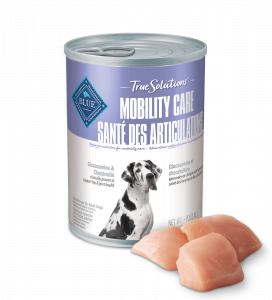
Blue True Solutions Wet Dog Food Review
Score: 3/10
Package Ingredients for Mobility Care Formula: Chicken (source of glucosamine and chondroitin sulfate), chicken broth, whitefish, potatoes, chicken liver, fish oil, brown rice, oatmeal, barley, flaxseed, pea flour, natural flavour, shrimp meal, carrageenan, guar gum, powdered cellulose, potassium chloride, cassia gum, taurine, salt, L-ascorbyl-2-polyphosphate (source of vitamin C), choline chloride, vitamin E supplement, L-Carnitine, zinc amino acid chelate, iron amino acid chelate, thiamine mononitrate (vitamin B1), copper amino acid chelate, manganese amino acid chelate, sodium selenite, cobalt amino acid chelate, niacin supplement (vitamin B3), calcium pantothenate (vitamin B5), vitamin A supplement, riboflavin supplement (vitamin B2), biotin (vitamin B7), vitamin B12 supplement, potassium iodide, pyridoxine hydrochloride (vitamin B6), vitamin D3 supplement, folic acid (vitamin B9), preserved with mixed tocopherols
Using our evaluation criteria, Blue True Solutions Wet is considered a high risk dog food. Here are our concerns:
Ingredient Quality
Overall, there are several concerns when it comes to ingredient quality:
High In Carbohydrate: Blue True Solutions Wet line averages 32% carbohydrate (as calculated on a dry matter basis), which is quite high for a canned food and indicates a lower quality food. Blue Buffalo states it doesn’t use wheat, corn or soy in these recipes, however they include peas, oatmeal, barley, potatoes and rice which are high in starch. High carbohydrate diets have been linked to gut imbalance. High carbohydrate diets also mean lower protein diets and average protein is 33% (dry matter), which is fairly low for a food in this category.
Excessive Added Vitamins and Minerals: When foods are highly processed and/or contain lower quality ingredients, a vitamin and mineral premix must be added for the food to meet minimum AAFCO nutritional requirements. These premixes can often cause toxicities, especially for vitamin D and copper.
Added Amino Acids: Protein from animals is more complete in amino acids than protein from plants – plus it’s more expensive. Foods with lower amounts of animal protein often need to add amino acids to compensate, so 2 or more added amino acids can be a marker of cheap, lower quality ingredients.
Unnamed Animal Ingredients: Unnamed animal ingredients are a sign of low quality. These foods contain fish oil that can be made from any type of fish. Unnamed animal ingredients are often a less expensive, low quality ingredient that can be made from rendered waste of many proteins.
Contains Plant Protein: Plant-based protein sources are the least expensive substitute for quality animal protein. Whenever possible, animal sources of protein are preferred because they contain a wider array of amino acids than plant based protein sources. Animal protein is more digestible.
Cellulose: Cellulose is low quality, insoluble fiber made from wood pulp. It’s the least expensive and least functional form of fiber since it’s very poorly fermented. In dog food, it’s often included to firm stools. Dogs have no known need for fiber, unless it’s soluble fiber that’s fermented by gut bacteria, to support gut health.
Ingredient Safety
Many pet food ingredients are unsafe or are grown using unsafe chemicals. Here are some concerns with Blue True Solutions Wet:
Highly Processed: Canned foods are heated before and during canning, which will cause significant losses in some active enzymes, vitamins, amino acids and phytonutrients.
High Pesticide/Herbicide Foods In The Top 5 Ingredients: The recipes in this line contain foods in the top 5 ingredients that are known to carry a large pesticide/herbicide residue. Peas (unless organic) are crops that are spray-dried with Roundup, leaving them with more glyphosate/herbicide residue than other crops, even genetically modified ones. Glyphosate is an antibiotic that can kill beneficial gut bacteria and has been linked to cancer and other diseases.
GMO Foods In The Top 5 Ingredients: These recipes contain known GMO ingredients in the top 5 ingredients that include potatoes. There are limited safety studies on genetically modified and Roundup Ready crops although they are lacking in nutrients compared to non-GMO foods. GMO crops also strip nutrients from soils, require increased pesticide risk and may be involved in bee die-off.
Carrageenan: Carrageenan is a highly processed derivative of seaweed used as a thickener or texturizer that may be linked to intestinal inflammation and other negative health effects.
Rice: Arsenic contamination is a significant concern with rice since it naturally absorbs arsenic which can contaminate the water it’s grown in. Arsenic is linked to chronic health issues.
Natural Flavor: Foods in this line contain natural flavor, which is added to make processed food more palatable. Natural flavor is often either MSG or animal digest, both low quality ingredients with limited safety studies.
Read more Blue Buffalo Dog Food Reviews
Is Blue Buffalo A Good Dog Food?
When evaluating ingredient quality and safety, scoring shows 4 out of 5 lines of Blue Buffalo dry dog foods to be very high risk foods. The Wilderness Dry line is considered high risk. These are ultra-processed foods with high levels of carbohydrates.
The canned dog foods, with less processing and fewer carbohydrates, score a bit better and are considered moderate to high risk dog foods.
Most of the recipes lost points for containing known ingredients known to have high pesticide/herbicide residues. Others lost points for GMO ingredients, unnamed animal proteins, seed oils, cellulose, natural flavor and excessive added vitamins and minerals.
Some recipes contain 2 or more added amino acids, which are a sign of foods with lower animal protein and often, more plant protein.
There are additional concerns with the dog food and marketing. These don’t affect the Blue Buffalo dog food reviews score, but they’re worth mentioning:
Glam Ingredients: Most Blue Buffalo dry dog foods contain glam ingredients. These are expensive or desirable ingredients like blueberries, cranberries, kale or apples often added to appeal to consumers but are below the salt in the ingredient list. This means they are included in minuscule amounts that contribute little or no nutritional value to your dog.
Ingredient Splitting: This is a technique of splitting ingredients into sub-categories to move certain ingredients higher or lower on the ingredient list. This is often used to disguise the amount of lower quality ingredients in the food, such as corn, potatoes or peas, and moves desirable ingredients, like proteins, higher.
Does Not State Farmed Vs Wild Caught Fish: These foods don’t specify whether the fish is farmed or wild caught. Farmed fish is less nutritious than wild caught fish and does not contain the same healthy fatty acid balance.
Does Not Provide Omega-6:Omega-3 Ratio: This omission is true of most foods. However it is a concern because omega-6 fatty acids are pro-inflammatory, and AAFCO allows a very inflammatory ratio of 30:1.
Blue Buffalo Recalls
Finally there have been several Blue Buffalo dog food recalls::
03/2017: Voluntary recall of Blue Wilderness canned dog food for potentially excessive levels of beef thyroid hormone.
02/2017: Voluntary recall of Homestyle Recipe dog food because of possible metal (aluminum) contamination. Also, voluntary recall of wet dog food cups because of a packaging problem.
05/2016: Limited voluntary recall due to moisture problems and the possibility of mold.
11/2015: Voluntary recall on a single lot of chew bones due to potential salmonella contamination.
10/2010: Voluntary recall because of a “sequencing error” made by an ingredient supplier when vitamin D carryover may have contaminated products.
04/2007: The FDA confirmed the presence of melamine in rice protein concentrate in food manufactured by American Nutrition Inc. for Blue Buffalo. Blue Buffalo denied knowledge or consent of the additive being in the product. It was part of the larger Menu Foods/melamine recall.
It’s also noteworthy that Purina filed a lawsuit against Blue Buffalo for false advertising of pet food after testing revealed the presence of poultry by-product meal in some of Blue Buffalo’s pet foods.
Evaluation Criteria
We evaluate and score dog foods based on two criteria:
Are the Ingredients High Quality?
Here are some common low quality ingredients or markers we look for:
- Is there excessive carbohydrate content, which can cause gut imbalances?
- Does the food contain unnamed proteins, which are low quality?
- Does the food use cellulose (wood pulp) as a source of fiber instead of real food?
- Are there excessive vitamins and minerals added in place of real food nutrition?
- Are there excessive added amino acids or plant proteins instead of expensive meat protein?
- Does the food contain inflammatory processed seed oils?
How Safe Are the Ingredients?
Many ingredients come from unhealthy, inflammatory sources or are full of pesticides so we look for:
- How processed is the food?
- Does the food contain known genetically modified foods?
- Does the food contain ingredients known to be high in pesticides?
- Does the food contain natural flavor, which are often MSG or animal digest?
- Does the food contain rice, which is high in arsenic?
Each food is objectively evaluated by these criteria and a score is assigned using the average of ingredient quality and safety. This is NOT a paid list and there are no affiliate links. Dogs Naturally has partnered with DogFoodReviews.com to make sure dog owners have unbiased, objective criteria to help them choose the best dog food on the market. You can view the full Evaluation Criteria at DogFoodReviews.com.

